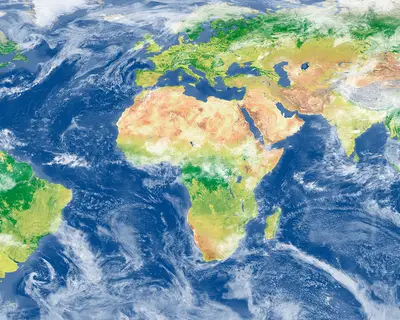RESEARCH TRIANGLE PARK, NC— A new study co-authored by RTI International finds systemic exclusion of marginalized communities in the climate adaptation planning of cities in the United States and around the world. As a result, the needs and priorities of wealthier and more privileged constituencies are well reflected in the planning while those of the most disadvantaged groups are often overlooked or ignored.
The study, published in the Journal of Planning Education and Research, evaluates land use planning activities in eight cities— Boston, New Orleans, Medellin (Colombia), Santiago (Chile), Metro Manila (Philippines), Jakarta (Indonesia), Surat (India), and Dhaka (Bangladesh)— and finds that despite differences in governance, geography, size, development levels, and climate risks and vulnerabilities, similar patterns of overlooking the needs of the poor manifest across climate adaptation planning in all of the cities. The study identifies simultaneous acts of omission, which favor certain privileged groups, and acts of commission, which deny resources and voice to marginalized communities and disproportionally displaces them.
“Often disadvantaged groups who contributed the least to climate change, are the ones who bear the brunt of the impacts and social adaptation costs,” said Kara Reeve, urban management specialist at RTI International and study co-author. “Our study finds a double injustice because those same disadvantaged groups that are vulnerable due to institutionalized injustices are now being excluded from the benefits of climate adaptation plans and interventions.”
In New Orleans and Dhaka, the urban poor continue to face disastrous flood risk despite the provision of protective infrastructure, which prioritizes wealthier communities. In New Orleans, low-income minority residents are not adequately protected from future natural disasters due to limited efforts to improve the city’s rising vulnerability to floods while historic power imbalances favor wealthier white neighborhoods over lower-income black communities. In post Katrina Recovery there have been no significant changes to land use patterns or the upgrading of protective infrastructure that would protect poor minority residents. African American neighborhoods in low lying areas have been targeted for replacement with with parks and green spaces; whereas similar flood-vulnerable white neighborhoods were not targeted for displacement. Similarly, in Dhaka, poor communities have been displaced by flood-exacerbating development, uneven land use enforcement, and urbanization pressures.
- In Boston and Surat, efforts to ensure green planning aligned with private sector interests and overruled the public benefit of those who are the most vulnerable. Because of the lack of public funding for adaptation, cities are reliant on the private sector for implementation, which can exacerbate existing unequal access to climate protection.
- In Manila and Medellin, climate adaptation plans resulted in land grabs from vulnerable populations. Unlike in the United States, where most property rights are clear and formal, informal settlements in developing countries have few legal protections, are easier to evict, and are located in areas targeted for infrastructure projects and more profitable private developments. In both places, more privileged neighborhoods have been able to continue expanding despite being located in protected areas or in areas categorized as high risk.
- In Santiago and Jakarta, the marginalized were often neglected in the planning process. For instance, the Climate Adaptation Plan for the Metropolitan Region of Santiago, although advertised as a participatory process, in fact did little to ensure participation of marginalized groups, either through direct representation or efforts to prioritize their adaptation needs.
“Today, adaptation planning seems to be a dual process of favoring certain privileged groups while simultaneously denying resources, rights, and voice to marginalized residents,” said Isabelle Anguelovski, senior researcher and principal investigator at UAB-ICTA (Universitat Autònoma de Barcelona–Institut de Ciènca I Tecnologia Ambientals) and co-author of the report “Planners have an obligation to advocate for transformative adaptation interventions that place justice front and center, and avoid marketing ‘resilient’ projects that merely re-package development-as-usual.”
The study recommends that in order to avoid even more injustice among the most vulnerable when seeking a climate adaptation plan, there needs to be an opportunity for planners to facilitate open, multilevel dialogues on evaluating climate risks, options, tradeoffs, and strategies.
The adaptation processes should also pay attention to issues of displacing and relocating the urban poor. This relocation could reinforce the institutionalized inequities that are responsible for vulnerabilities in the first place.
Funding for the research was provided by the David L. Boren Fellowship, administered by the United States National Security Education Program, the Indian Council for Research on International Economic Relations, and RTI. Study co-authors are affiliated with Massachusetts Institute of Technology, USA; Universitat Autònoma de Barcelona, Spain; University of Amsterdam, the Netherlands; and University of California – Los Angeles.

- Exclusion of marginalized communities appears in all four studied aspects of climate adaptation planning in the context of land use—infrastructure planning, land use regulations, participatory processes, and engagement with the private sector
- The study identifies simultaneous acts of omission, which favor certain privileged groups, and acts of commission, which deny resources and voice to marginalized communities and disproportionally displaces them
RTI International Media Relations:
As an independent, scientific research institute with a mission to improve the human condition, RTI International is engaged by clients and partners to conduct evidence-based research and project implementation. We share our work in line with journalistic and scientific standards and maintain a record in RTI’s Newsroom.
RTI International is an independent scientific research institute dedicated to improving the human condition. Our vision is to address the world's most critical problems with technical and science-based solutions in pursuit of a better future. Clients rely on us to answer questions that demand an objective and multidisciplinary approach—one that integrates expertise across social, statistical, data, and laboratory sciences, engineering, and other technical disciplines to solve the world’s most challenging problems.
For more information, visit www.rti.org.
